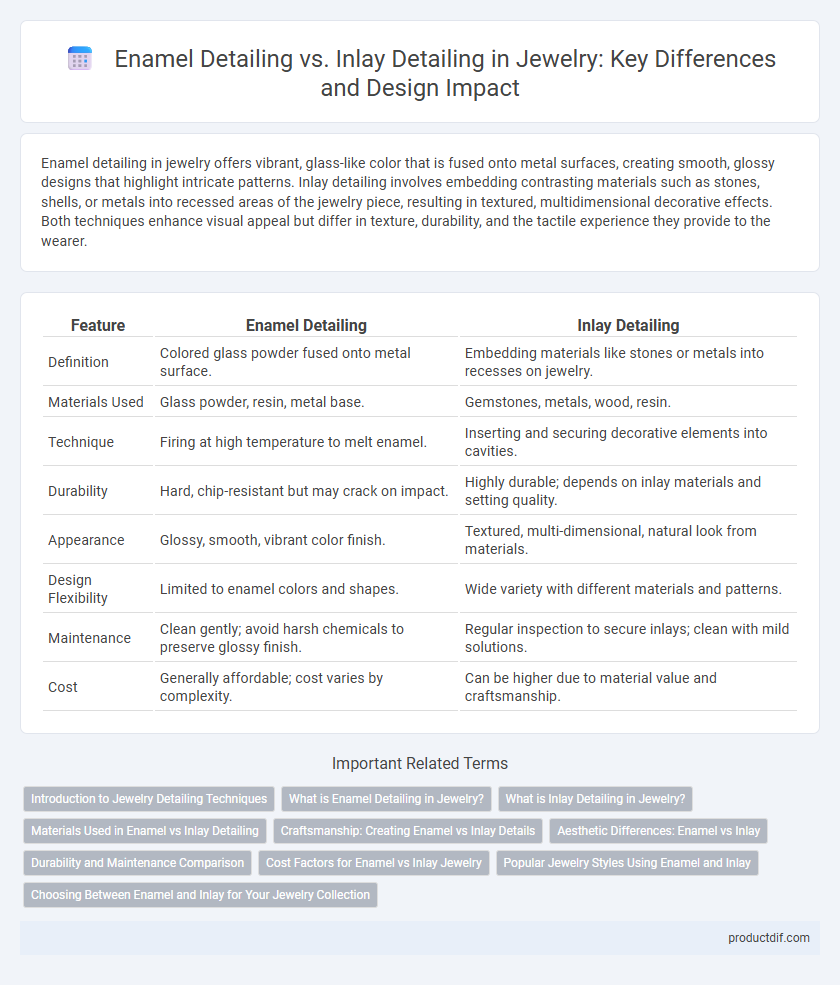Enamel detailing in jewelry offers vibrant, glass-like color that is fused onto metal surfaces, creating smooth, glossy designs that highlight intricate patterns. Inlay detailing involves embedding contrasting materials such as stones, shells, or metals into recessed areas of the jewelry piece, resulting in textured, multidimensional decorative effects. Both techniques enhance visual appeal but differ in texture, durability, and the tactile experience they provide to the wearer.
Table of Comparison
| Feature | Enamel Detailing | Inlay Detailing |
|---|---|---|
| Definition | Colored glass powder fused onto metal surface. | Embedding materials like stones or metals into recesses on jewelry. |
| Materials Used | Glass powder, resin, metal base. | Gemstones, metals, wood, resin. |
| Technique | Firing at high temperature to melt enamel. | Inserting and securing decorative elements into cavities. |
| Durability | Hard, chip-resistant but may crack on impact. | Highly durable; depends on inlay materials and setting quality. |
| Appearance | Glossy, smooth, vibrant color finish. | Textured, multi-dimensional, natural look from materials. |
| Design Flexibility | Limited to enamel colors and shapes. | Wide variety with different materials and patterns. |
| Maintenance | Clean gently; avoid harsh chemicals to preserve glossy finish. | Regular inspection to secure inlays; clean with mild solutions. |
| Cost | Generally affordable; cost varies by complexity. | Can be higher due to material value and craftsmanship. |
Introduction to Jewelry Detailing Techniques
Enamel detailing in jewelry involves fusing powdered glass onto metal surfaces to create vibrant, glossy colors that enhance artistic expression. Inlay detailing, on the other hand, incorporates precious or semi-precious materials such as gemstones, mother-of-pearl, or wood into recessed areas of the metal, providing contrasting textures and depth. Both techniques demand precision and craftsmanship, significantly influencing the aesthetic and value of fine jewelry pieces.
What is Enamel Detailing in Jewelry?
Enamel detailing in jewelry involves fusing powdered glass to a metal surface through high heat, creating a smooth, colorful finish that enhances the piece's aesthetic appeal. This technique allows for vibrant colors and intricate designs that are both durable and resistant to tarnish. Unlike inlay detailing, which embeds materials such as gemstones or contrasting metals into the jewelry, enamel provides a glossy, painted effect that can mimic intricate patterns or bold color blocks.
What is Inlay Detailing in Jewelry?
Inlay detailing in jewelry involves setting small pieces of materials such as gemstones, mother-of-pearl, or metals into carved recesses on the jewelry surface, creating intricate patterns or images. This technique contrasts with enamel detailing, which uses colored glass powder fused onto metal to add vivid coloration. Inlay is prized for its durability and the tactile texture it adds, often resulting in a mosaic-like effect that enhances the overall design with depth and dimension.
Materials Used in Enamel vs Inlay Detailing
Enamel detailing in jewelry involves fusing powdered glass onto metal surfaces, typically copper, gold, or silver, to create vibrant, glassy finishes resistant to fading and scratching. Inlay detailing incorporates materials such as gemstones, mother-of-pearl, or wood carefully set into recessed areas within metal settings, often gold, silver, or platinum, resulting in intricate and textured designs. The choice of materials directly impacts the durability, visual depth, and color range achievable through enamel or inlay techniques.
Craftsmanship: Creating Enamel vs Inlay Details
Enamel detailing involves applying powdered glass fused through high heat to create vibrant, glossy surfaces requiring precise temperature control and layering techniques. Inlay detailing demands embedding contrasting materials such as gemstones, metals, or mother-of-pearl into recessed areas, showcasing meticulous carving and fitting skills. Both craftsmanship methods highlight an artisan's expertise in texture manipulation and durability enhancement for intricate jewelry designs.
Aesthetic Differences: Enamel vs Inlay
Enamel detailing in jewelry uses vibrant, glass-like coatings that create smooth, colorful surfaces, offering a glossy and translucent finish ideal for intricate designs with striking, vivid hues. Inlay detailing involves embedding materials like stones, metals, or shells into the metal base, producing a textured, mosaic-like appearance with a rich, three-dimensional quality and natural variations. The aesthetic difference lies in enamel's seamless, shiny look contrasted with inlay's tactile, varied textures that enhance the piece's depth and character.
Durability and Maintenance Comparison
Enamel detailing offers vibrant color and a smooth finish but requires careful maintenance to prevent chipping and fading over time. Inlay detailing, often using precious stones or metals set into the jewelry, provides superior durability and resistance to wear. Both techniques demand regular cleaning, but enamel pieces are more sensitive to harsh chemicals, while inlay designs withstand daily use with minimal upkeep.
Cost Factors for Enamel vs Inlay Jewelry
Enamel detailing in jewelry typically involves applying powdered glass fused at high temperatures, leading to moderate production costs due to material expenses and skilled labor requirements. Inlay detailing, which requires embedding materials like gemstones or metals into recessed areas, generally incurs higher costs because of intricate craftsmanship and the value of inlay materials. Cost differences also arise from durability considerations, with enamel potentially needing more maintenance, whereas inlays tend to offer longer-lasting wear, influencing overall value and pricing.
Popular Jewelry Styles Using Enamel and Inlay
Popular jewelry styles using enamel detailing include cloisonne, champleve, and plique-a-jour, which offer vibrant color and intricate patterns. Inlay detailing is prominently featured in Native American turquoise jewelry, opal inlays in rings, and mother-of-pearl designs in bracelets, emphasizing contrast and texture. Both techniques enhance jewelry aesthetics by combining durability with artistic expression, appealing to collectors and fashion enthusiasts alike.
Choosing Between Enamel and Inlay for Your Jewelry Collection
Enamel detailing involves fusing powdered glass to metal, creating vibrant, glossy surfaces that resist fading and add colorful highlights to jewelry pieces, making it ideal for bold, artistic designs. Inlay detailing uses the precise fitting of contrasting materials like gemstones, wood, or metal into recesses, offering intricate patterns and texture variations that enhance elegance and depth. Selecting between enamel and inlay depends on desired aesthetics, durability, and the specific statement you want your jewelry collection to convey.
Enamel Detailing vs Inlay Detailing Infographic

 productdif.com
productdif.com